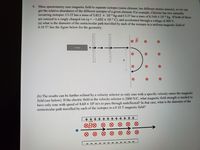Question

Transcribed Image Text:6. Mass spectrometry uses magnetic field to separate isotopes (same element, but different atomic masses), so we can
get the relative abundance of the different isotopes of a given element. For example, Chlorine has two naturally
occurring isotopes: Cl-35 has a mass of 5.812 x 10-26 kg and Cl-37 has a mass of 6.144 x 10-6 kg. If both of these
are ionized to a singly charged ion (q = -1.602 × 10-" C), and accelerated through a voltage of 400 V,
(a) what is the diameter of the semicircular path travelled by each of the isotopes in a uniform magnetic field of
0.10 T? See the figure below for the geometry.
lonizer
(b) The results can be further refined by a velocity selector so only ions with a specific velocity enters the magnetic
field (see below). If the electric field in the velocity selector is 2000 N/C, what magnetic field strength is needed to
have only ions with speed of 4.60 x 10' m/s to pass through undeflected? In that case, what is the diameter of the
semicircular path travelled by each of the isotopes in a 0.10 T magnetic field?
++++ + +++ + + + +
OB® O
Expert Solution
This question has been solved!
Explore an expertly crafted, step-by-step solution for a thorough understanding of key concepts.
This is a popular solution
Trending nowThis is a popular solution!
Step by stepSolved in 4 steps

Knowledge Booster
Similar questions
- 10. What prevents gravity from pulling you through the ground to the center of Earth? Choose the best answer. A. The positive nuclei of your body's atoms repel the positive nuclei of the atoms of the ground. B. The density of the ground is greater than the density of your body. C. Atoms are bound together by chemical bonds. D. Electrons on the ground's surface and the surface of your feet repel one another.arrow_forwardHelp with these problemsarrow_forward1. The equation q = ne tells us that charge is quantized in the form of small packets. Note that q is charge in coulomb (C), e is the charge of the electron, and n is the number of electrons. Using this equation, calculate the number of electrons that make up a charge of +24mC.arrow_forward
arrow_back_ios
arrow_forward_ios